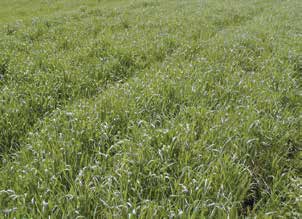chAPter 10 Cover CroPs
Figure 10.2. Velvet bean grown on hillsides in Central America. Left: growing vines; middle: maturing pods; right: mulched under corn crop. Left and middle photos by Ray Bryant.
maturity and harvested for seed, they do not add much
reliably winterkill every year, and the small amounts
in the way of lasting residues or nitrogen.
of extra fall growth and nitrogen fixation may not be
Velvet bean (mucuna) is widely adopted in tropi-
worth the extra cost of the seed compared with peren-
cal climates. It is an annual climbing vine that grows
nial varieties.
aggressively to several feet high and suppresses weeds
Crown vetch is adapted only to well-drained soils,
well (figure 10.2). In a velvet bean–corn sequence, the
but it can be grown under lower fertility conditions than
cover crop provides a thick mulch layer and reseeds
alfalfa. It has been used successfully for roadbank stabi-
itself after the corn crop. The beans themselves are
lization and is able to provide permanent groundcover.
sometimes used for a coffee substitute and can also be
Crown vetch has been tried as an interseeded “living
eaten after long boiling. A study in West Africa showed
mulch,” with only limited success at providing nitrogen
that velvet bean can provide nitrogen benefits for two
to corn. However, it is relatively easy to suppress crown
successive corn crops.
vetch with herbicides to reduce its competition with
Similar tropical cover crops include Canavalia,
corn. Crown vetch establishes very slowly, so it should
Crotalaria, Tephrosia, all of which can be used as
be used only for perennial cover.
mulches after maturing.
Red clover is vigorous, shade tolerant, winter-
hardy, and can be established relatively easily. It is com-
Biennial and Perennial Legumes
monly interseeded with small grains. Because it starts
Alfalfa is a good choice for well-drained soils that are
growing slowly, the competition between it and the
near neutral in pH and high in fertility. The good soil
small grain is not usually great. Red clover also success-
conditions required for the best growth of alfalfa make it
fully interseeds with corn in the Northeast.
a poor choice for problem situations. Where adapted, it
Sweet clover (yellow blossom) is a reasonably
is usually grown in a rotation for a number of years (see
winter-hardy, vigorous-growing crop with an ability to
chapter 11). Alfalfa is commonly interseeded with small
get its roots into compacted subsoils. It is able to with-
grains, such as oats, wheat, and barley, and it grows
stand high temperatures and droughty conditions better
after the grain is harvested. The alfalfa variety Nitro can
than many other cover crops. Sweet clover requires a
be used as an annual cover crop because it is not very
soil pH near neutrality and a high calcium level; it does
winter-hardy and usually winterkills under northern
poorly in wet, clayey soils. As long as the pH is high,
conditions. Nitro continues to fix nitrogen later into the
sweet clover is able to grow well on low-fertility soils.
fall than winter-hardy varieties. However, it does not
It is sometimes grown for a full year or more, since it
105
Building SoilS for Better CropS: SuStainaBle Soil ManageMent





